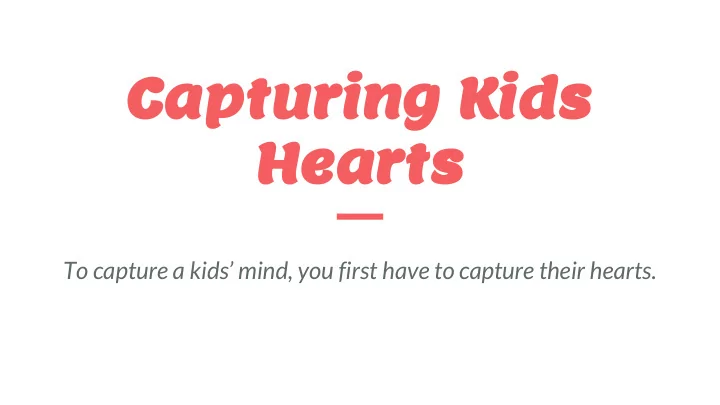

Capturing Kids Hearts To capture a kids’ mind, you first have to capture their hearts.
Why Capturing Kids Hearts?
What makes CKH different? ★ Process not a program ★ Goals: ○ High performing team - staff and students ○ Group self-management ○ Great for all relationships, not just school-related
Good Things ★ Shows interest in the students ★ Set a positive tone for the class ★ Teaches and models the leadership skill of positive thinking ★ 3-5 minutes to share
Social Contract ★ One of the key pieces of CKH ★ Becomes the centerpiece of the classroom culture ★ Built on 4 basic questions ○ How do you want to be treated by me (leader)? ○ How do you want to be treated by each other? ○ How do you think I (leader) want to be treated by you? ○ How do you want to treat each other when there is conflict?
Social Contract ★ Every contract includes 3 ideas: effort, listening, no put-downs ★ Respect is also a key element ★ Questioning helps process the specifics of what that looks like (playground, lunch, etc.)
Handshaking ★ Positive start to the day ★ Lets teachers and students check-in ★ Teaches students a professional greeting
Hand Signals ★ Reinforces the goal of becoming a high performing, self-managing group nonverbally ★ Holds personal and group accountability to the social contract
Time Out ★ Non-verbal signal to gain attention ★ Students mimic signal to let other know it’s time to come back together ★ Uses both hands to limit hand-held distractions
Check/Help A Friend ★ Encouragement to do the right thing ★ Call to greatness ★ One and done ★ Adult will handle after one attempt is made
Foul ★ Used sparingly when feelings are hurt ★ Can be called by an “upstander” ★ Two put ups are a start to rebuilding the relationship ★ Can be given after a break if needed
Four Questions ★ Goal is to avoid power struggles and increase on task behaviors ★ Tone and body language are critical to success of questions ★ Disrespect is handled separately from misbehavior ★ Know what answer you are expecting to the questions. If the child answers correctly, move to the next question
Four Questions 1. What are you doing? 2. What are you supposed to be doing? 3. Are you doing it? 4. What are you going to do about it?
Four Questions - Disrespect 1. How are you talking to me? 2. How are you supposed to be talking to me? 3. Are you doing it? 4. What are you going to do about it?
Behave Out/In ★ Goal: To maintain the boundaries, while preserving the relationship. ★ Students own the decisions that lead to “Behaving Out/In” ★ Behaving out could be out of your group to the table to finish your work and then you behave in. It could be to another classroom or to the office. ★ Cuts down on referrals
CKH is a process ★ Public learners ★ Mistakes will happen as with any new skill ★ Reteaching is critical to the process ★ Open communication will be important
Questions?
Recommend
More recommend